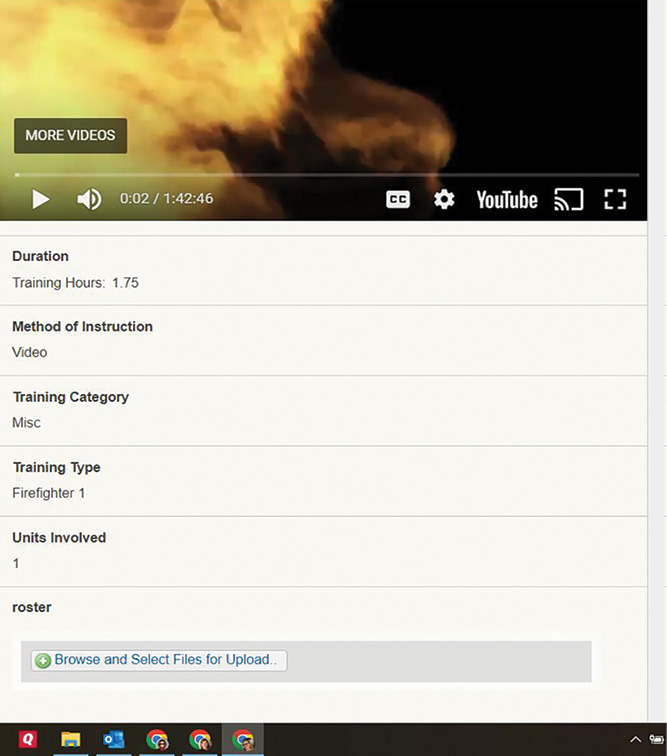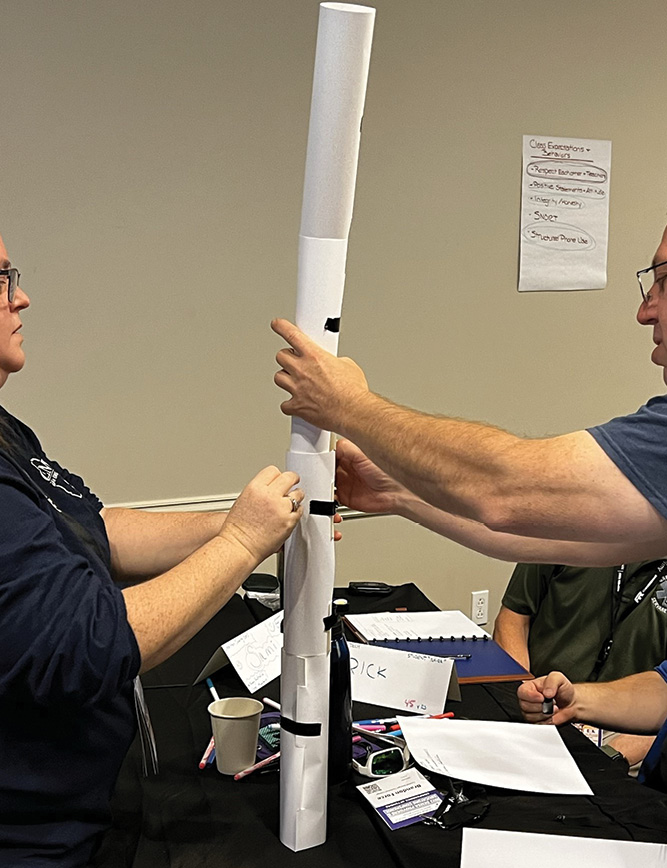BY JENNIFER STANISLAW
How many firefighters remember school, drill, or academy as hours of experienced people standing by a PowerPoint® presentation and droning on and on and on, with nothing interesting except for an occasional war story?
- The Staffing Dichotomy: Quality vs. Quantity
- New Fire Personnel, Organizational Change, and a Foundation of Development
- Reevaluating Firefighter Recruitment: Finding the Best People
We, as students, were expected to “sit and get” from the “sage on the stage.” If we didn’t get it, it was our fault. We needed to retain that knowledge and apply it, often out of context. If we failed, it was our fault, not that of the fire instructor.
If we were fortunate enough to play school well enough, we passed and were sent out into the world for the “real” learning. As our time in service progressed, we suffered through hours of drills and continuing education classes. Later, we may have been fortunate enough to take on educator roles in our careers. We taught as we had been taught. Our expectations of our students matched those our fire instructors had of us. And the cycle continues. You may have heard that the fire service is “200 years of tradition, unimpeded by progress.” But times, they are a-changin’—and we need to change with them.
Core Values and Learning Styles
How many “good” firefighters, EMTs, and paramedics have left this field because they didn’t “play school” well? This profession is not for everyone. It takes a special breed to be able to handle the unique knowledge, skills, and abilities required of the fire service. Our profession also requires us to believe in the following core values:
- Integrity.
- Leadership.
- Loyalty.
- Sacrifice.
- Service above self.
- Honor.
- Duty.
Of course, we should never lower our standards just to fill vacant positions. But going back to the original question, how many of those “good” people have we lost simply because they just couldn’t take “sit and get”—maybe because their brains worked differently, their backgrounds were different, or they just learned differently? What strengths could they have brought to our profession if their educators knew how to account for the range of different learning styles that we know exists?
A New Approach
It’s worth considering a different approach—a way of training, educating, and teaching that will maintain the same level of rigor and complete the same objectives we’ve always had. What if someone showed you techniques and approaches for education and training that would increase engagement and retention—techniques that can and do account for the various learning styles of students who sit in the chairs in our classroom, drill hall, or station house? These techniques increase the learner’s engagement.
Types of Engagement
What is engagement? Engagement is active participation or involvement in the learning process. The key word here is active. With the “sit and get” from the “sage on the stage,” the learning, if it happens at all, is a passive process. The learners sit back and listen, and the instructor expects them to absorb the information without significant interaction or engagement. But there’s a catch: Without interaction or engagement, the ability for the learners to appropriately apply what they are learning is limited. Passive teaching techniques present many problems, including one-way communication, limited interaction, and limited critical thinking.
With one-way communication, the learner receives information in a unidirectional manner. Often this is through lectures, presentations, and recorded videos. The learner’s role is to listen, watch, or read. The learner has limited opportunity to ask questions or clarify concepts. One-way communication is the most efficient way for the educator—the sage—to pass knowledge along. The onus is on the recipient to learn, retain, and apply the knowledge being presented.

1. Video platform for training. (Photos by author.)
Video-based continuing education platforms are growing increasingly popular with some agency leadership (photo 1), and for a few strong reasons:
Economical.- Recording a video and assigning it as mandatory training is budget friendly.
- The learners can watch the video on their downtime at the station or at home.
- Video-based training doesn’t require a unit to go out-of-service or other companies to cover during training.
One-way communication means limited interaction. Putting aside the video instruction approach (which does have its time and place), one-way communication is often how lectures and presentations happen. I have attended several conference sessions delivered by incredibly talented educators and experts. I have taken pages upon pages of notes. But I often had questions and, due to the nature of the session, I was unable to ask. Without the interaction, my retention dipped. And, unfortunately, those notes often ended up filed away, and only a portion of the information really stuck with me.
Critical Thinking
Much of our job requires the ability to think critically. And what, exactly, is critical thinking? Critical thinking is a process that involves analyzing and evaluating information to make well-informed decisions. A person who can think critically seeks to understand, assess, and apply information logically and systematically.
Critical thinking requires a deep understanding of all aspects of a subject. As firefighters, we must have a deep understanding of fire behavior, building construction, tactical ventilation, fire streams, water supply, and more. EMTs and paramedics must have a deep understanding of anatomy, physiology, pathophysiology, pharmacology, body systems, and more. In professions like these, critical thinking has life-and-death consequences—for us and for the public we serve. So how can we rely on an education and training system that limits our ability to ask questions of experts?
Perspective
Many educators and trainers have been doing this work for decades. I’ve heard them make comments like, “These young pups just don’t have the attention span that we did when we were their age.” In some ways, that’s an accurate statement. Many of today’s students had tablets or smartphones in their hands before any formal education began. The younger generation entering the fire service grew up in a world not knowing what boredom is. And, frankly, listening to someone drone on during a PowerPoint presentation is generally less than exciting, no matter when you were born. We, as educators, often must battle the tiny computer in our students’ pockets to get their attention. So, what do we do?
We must make learning a more engaging, learner-centered process. We need to get rid of the “sit and get,” “sage on the stage” mentality that many of us have followed for a lifetime.
It’s time to modernize our instructional methods. Students need coaches, facilitators, and guides who help them discover knowledge on their own. It’s time to shift the focus away from traditional lectures to more interactive and collaborative activities. Wouldn’t you describe our profession as interactive and collaborative? Then why wouldn’t we strive to educate in the same manner?
Firefighting is a profession of action; why do we educate so passively? Let’s start engaging in active teaching for active learning. But what, exactly, is active learning? Active learning happens when students are involved with the learning process. This happens through discussions with peers and whole groups, problem-solving activities, debates, case studies, and hands-on experiences (photo 2). Active learning is collaboration. It promotes teamwork, communication, and the sharing of diverse perspectives. Doesn’t that sound more like the fire service?

2. Engagement Strategies class.
So how does one turn from a sage on the stage to a learning coach? It happens through engagement strategies, a group of teaching techniques that shift learning from a passive process to an active one. And there’s good news: Implementing engagement strategies into a training and education program isn’t difficult or expensive, but it does require some time, adjustment, patience, and practice.
You can find hundreds of techniques to try. Do a search for “engagement strategies” on Google or YouTube and you’ll be overloaded with experts touting tricks and tips. It’s good to have an idea of what you’re looking for, as sifting through search results can become overwhelming.
When I entered the education realm full time, I was fortunate enough to have mentors who gave me two helpful pieces of advice:
- Remember that the person doing the speaking is the person doing the learning. As educators, the more we teach a subject, the better we understand it. That is, in part, because we are always talking about it. We answer questions about the subject and need to formulate responses for a varied audience, which deepens our own understanding of the material. This concept also applies to instances when we ask our students to do the talking. Ways to get them talking include debates, classroom discussions, philosophical chairs, Socratic seminars, think-pair-shares, and more.
- Get your students moving. It’s widely known and reported that physical activity is good for the brain. In fact, in her 2023 Aspen Institute talk called The Astonishing Effects of Exercise on Your Brain, Wendy Suzuki, dean of the College of Arts & Science and professor of neural science and psychology at New York University, said, “Simply moving your body has long-lasting and protective benefits for your brain that will last a lifetime.”1
The movement doesn’t have to be rigorous or disrupt the teaching. You can incorporate activities like brain breaks, four corners, or snowball into your lesson to help switch from passive to active learning.
ENDNOTE
1. Suzuki, Wendy, “The Astonishing Effects of Exercise on Your Brain,” Aspen Ideas Festival, The Aspen Institute, June 29, 2023. bit.ly/3SYFNfU.
JENNIFER STANISLAW leads the West Salem (OR) High School Emergency Services Program and is a paramedic and volunteer firefighter for Jefferson Rural Fire Protection District with more than 25 years of experience. She is currently working on her doctorate in leadership studies.

